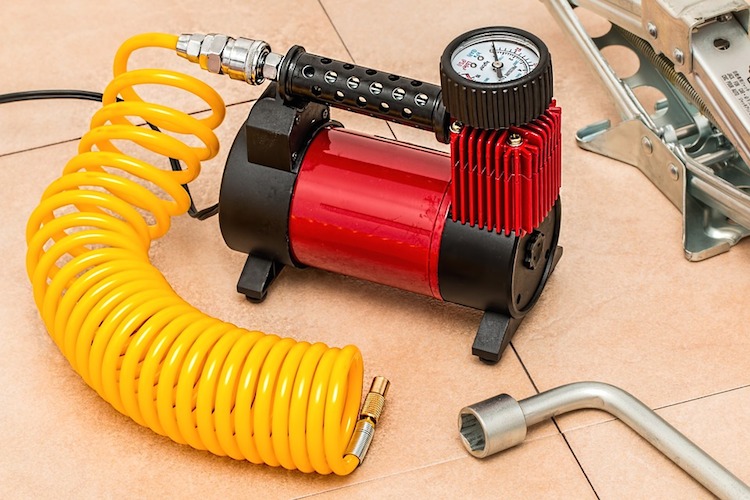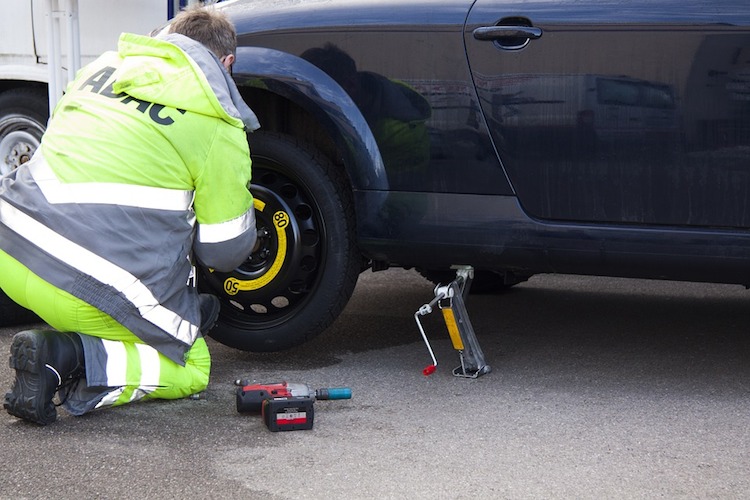If you are the observant type, then you are aware of the type of tire aid kit you have stashed away in your trunk or sitting in some other alcove within your SUV, truck, or minivan.
It wasn’t too long ago that a full-size spare served as the fifth tire in almost all vehicles, but today you may find a “donut” spare, a repair kit or no spare at all thanks to run-flat tires. We’ll take a look at each flat tire aid option and what this could mean for you during an emergency.
The Traditional Spare Tire
For decades, manufacturers provided consumers with a full-size spare tire wrapped within a wheel. Such spares matched the other four tires and were usually included in tire rotation patterns, ensuring even wear amongst all five.
First-time drivers learned how to change spares, finding a lug wrench and a scissor jack next to the spare. Practicing how to change a tire was a teen rite of passage, at least for those who anxiously awaited their driver’s license and perhaps purchased their first car.
The benefit of a full-size spare is that you can drive it at a normal speed and keep the spare on the wheel for as long as you want. Just remember to fix the flat before making it your new spare! On the other hand, changing a tire isn’t easy — they’re heavy and if you have to change it on the side of the road, you might put yourself and others in danger.
Are Spare Tires Smaller?
It was sometime in the late 1980s or early 1990s, when Original Equipment Manufacturers (OEMs) began substituting full size spares for smaller tires, typically known as compact or “donut” spares. Although smaller than conventional tires, compact spares are a sufficient, but a temporary replacement for your other tires.
The earliest compact spares were stored deflated, with a can of compressed carbon dioxide included for quick inflation. Later, manufacturers developed already inflated compact spares requiring no inflation prior to mounting. Compact spares are designed for short drives and operated at speeds below 50 mph.
Manufacturers like them because they fit in small or tight spaces, freeing up room for other storage. They also cost less. From the consumer’s perspective, they’re easier to lift and install than conventional spare tires.
There are several disadvantages too, including compact spares simply do not have the same level of grip as conventional tires. This can affect braking and handling, making it more difficult to stop and control the vehicle.
An installed compact spare might also affect cars equipped with a rear differential, putting stress on this component. Clearly, only use a compact spare tire briefly before fixing your flat and mounting it back on the wheel.
Your No Spare Option: A Tire Repair Kit

In place of spare tires, some manufacturers aren’t using them at all. Instead, you’ll find a tire repair kit comprised of a flat fixer sealant and a small portable air compressor.
Such kits are useful, but only if your tire absorbs the screw or nail. If the tire is cut, split or blows out, then you’ll have to call for help.
A Better Way: Run-Flat Tires
Yet another option for car owners are run-flat tires. They’re more commonly found on new cars, especially luxury models. The following FAQs may help you decide if they’re right for you.
Are Run-Flat Tires Good?
Yes. Who needs a spare tire when your tires cannot go flat? So-called run-flat tires are designed just as the name implies: if you run over a nail or glass, your tires aren’t likely to go flat. Instead, self-sealing properties within the tread close up around the object.
Are Run-flat Tires Repairable?
Not always. Run-flat tires can’t handle every tire issue. Indeed, if you have a blowout, the tire is no good — the same can be said for any tire, however. Without a spare, you’ll have to call for help.
Are Run-flat Tires Safer?
Run-flat tires may be the safest choice for car owners. Instead of finding yourself stuck by the side of the road, you can keep driving — up to 100 miles. In this case, you don’t have to worry about getting involved in an accident if you pull off to the side of the road.
There are some drawbacks — run-flat tires wear out faster and are more expensive to replace.

Are Spare Tires Required by Law?
Spare tires are not required by law and that’s one reason why manufacturers are eliminating them or providing other options.
Concerning your personal options, the best-laid plans for the prepared car owner will sometimes fail. A backup plan is necessary and may involve roadside assistance.
If you own a new car, the plan may be included with your warranty. For everyone else, joining a roadside assistance club may supply the assurance you need to avoid becoming stranded for hours on the side of a dangerous road.
Sources
- Popular Mechanics: How Long Can You Really Use Your Spare Tire? — http://www.popularmechanics.com/cars/how-to/a3254/how-long-can-you-really-use-your-spare-tire-7710515/
- National Motorist Association Blog: What Ever Happened To The Full-Size Spare Tire? — https://www.motorists.org/blog/full-size-spare-tire-abandonment/
- TireRack.com: Tire Tech — Flat Tire Repairs – After Driving on Flat Run-Flat Tires — https://www.tirerack.com/tires/tiretech/techpage.jsp?techid=226
- CarTalk: Today: Does Fix-A-Flat Really Work? — https://www.cartalk.com/blogs/dear-car-talk/today-does-fix-flat-really-work
- ABC News: ‘GMA’ Investigates: New Cars Being Sold Without Spare Tires — http://abcnews.go.com/US/gma-investigates-cars-sold-spare-tires/story?id=36435661
- Edmunds.com: The Pros and Cons of Run-Flat Tires — https://www.edmunds.com/driving-tips/run-flat-tires-a-primer.html
Related Reading
- The Skinny on Summer Tires
- Replacement Tires: Where to Buy Them
- Michelin, GM Collaborate on Airless Tires
- How to Buy New Tires for Your Car
Photo attribution – First photo: Auto Trends Magazine. Second and third photos: Pixabay.com.
- 2024 Mazda CX-50: A Compact SUV with Premium Aspirations - Apr 15, 2024
- 2024 Ford Mustang (Iconic Pony Car Evolves) - Apr 4, 2024
- 2024 Ford Maverick (Looks Like a Truck, Drives Like a Car) - Mar 28, 2024


